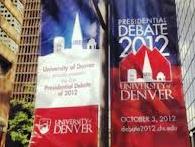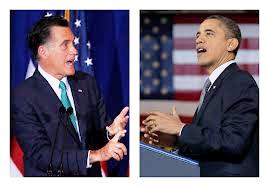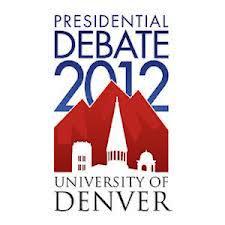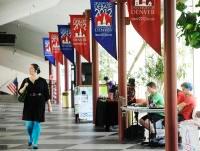» posted on Monday, October 1st, 2012 by Linda Lou Burton
It’s Debatable
 Linda Burton posting from Denver, Colorado – Everybody is talking about the traffic. Big city news teams always devote a lot of time to talking about traffic congestion, road closures, alternate routes, and commute times. It soothes, or creates, commuter anxiety – how long will it take me to get to work? Or more importantly, how long will it take me to get home? It’s usually the weather that causes kinks in the routine, but this week in Denver the Secret Service is the slammer-jammer that gets the blame. It has called for the shutdown of a portion of the freeway (Interstate 25!) on Wednesday between 5-10 PM, which is causing some employers
Linda Burton posting from Denver, Colorado – Everybody is talking about the traffic. Big city news teams always devote a lot of time to talking about traffic congestion, road closures, alternate routes, and commute times. It soothes, or creates, commuter anxiety – how long will it take me to get to work? Or more importantly, how long will it take me to get home? It’s usually the weather that causes kinks in the routine, but this week in Denver the Secret Service is the slammer-jammer that gets the blame. It has called for the shutdown of a portion of the freeway (Interstate 25!) on Wednesday between 5-10 PM, which is causing some employers  to excuse employees early, IF they will be impacted by that closure. What is all the hullabaloo? A Presidential Debate at the University of Denver, the first of the scheduled debates between incumbent President Barack Obama and Republican candidate Mitt Romney. And just as it happens when a city hosts the Olympics, or some other highly significant event, people are alternately grousing about the hassle, and preening at the national attention. Is it worth it?
to excuse employees early, IF they will be impacted by that closure. What is all the hullabaloo? A Presidential Debate at the University of Denver, the first of the scheduled debates between incumbent President Barack Obama and Republican candidate Mitt Romney. And just as it happens when a city hosts the Olympics, or some other highly significant event, people are alternately grousing about the hassle, and preening at the national attention. Is it worth it?
 Denver is a city of 600,158 with a metro area of 2,552,195; it’s called the mile-high city (stand on the 13th step of the state capitol and you will be standing at 5,280 feet). Two freeways cross paths in Denver, Interstate 25 leads you north to Cheyenne and south to Santa Fe; Interstate 70 leads you east to Topeka and west to Interstate 15, where you can head north to Salt Lake City. That explains why there are so many cars making all that traffic news every day.
Denver is a city of 600,158 with a metro area of 2,552,195; it’s called the mile-high city (stand on the 13th step of the state capitol and you will be standing at 5,280 feet). Two freeways cross paths in Denver, Interstate 25 leads you north to Cheyenne and south to Santa Fe; Interstate 70 leads you east to Topeka and west to Interstate 15, where you can head north to Salt Lake City. That explains why there are so many cars making all that traffic news every day.
 But how did it happen that the University of Denver (referred to as DU) is hosting this prestigious, traffic-jamming debate? Is it because DU is located in a big city in a swing state? Well actually, they simply applied for it, and then hunkered down to make it work. The Commission on Presidential Debates (a non-profit, non-partisan organization that has run all debates since 1988) sets forth the qualifying criteria – an air-conditioned hall of at least 17,000 square feet; nearby parking that can accommodate 30 television satellite and news trucks; and a 20,000 square foot media filing center, known as “spin alley.” DU measured up to that, and since their selection a year ago have been working like a house afire to ensure a logistical success.
But how did it happen that the University of Denver (referred to as DU) is hosting this prestigious, traffic-jamming debate? Is it because DU is located in a big city in a swing state? Well actually, they simply applied for it, and then hunkered down to make it work. The Commission on Presidential Debates (a non-profit, non-partisan organization that has run all debates since 1988) sets forth the qualifying criteria – an air-conditioned hall of at least 17,000 square feet; nearby parking that can accommodate 30 television satellite and news trucks; and a 20,000 square foot media filing center, known as “spin alley.” DU measured up to that, and since their selection a year ago have been working like a house afire to ensure a logistical success.
Money was involved too; DU had to raise $1.65 million to host the event, which they did, through sponsors and fundraising. After all, a spotlight like this could impact enrollment and fundraising efforts for years to come. The debate is expected to bring 12,000 people to campus, including more than 4,000 national and international journalists who will broadcast to an audience estimated at more than 80 million. Presidential debates are the second-most watched events in America, surpassed only by the Super Bowl, which draws about 111 million viewers.
 That’s quite a large feather in the cap of this small but distinguished university; it’s been around since 1864 and has a faculty of 1,200; a staff of 1,645; and a student body of 12,000 from 48 states and 50 different countries. DU claims some well-known alumni from its school of Law, Politics & Public Affairs, such as Condoleezza Rice, former US Secretary of State; Gale Norton, former US Secretary of the Interior; James Nicholson, former US Secretary of Veterans Affairs, and an assortment of governors and US Senators.
That’s quite a large feather in the cap of this small but distinguished university; it’s been around since 1864 and has a faculty of 1,200; a staff of 1,645; and a student body of 12,000 from 48 states and 50 different countries. DU claims some well-known alumni from its school of Law, Politics & Public Affairs, such as Condoleezza Rice, former US Secretary of State; Gale Norton, former US Secretary of the Interior; James Nicholson, former US Secretary of Veterans Affairs, and an assortment of governors and US Senators.
 So point your TV to any station October 3 at 7 PM and watch the debate; PBS NewsHour Executive Editor Jim Lehrer is moderating the event; domestic issues will be featured – that should cover the economy and health care. It’s not designed to be a big-crowd event, but a media-fest; the Commission decides on how many tickets are available, and how they are distributed. A lottery this morning doled out tickets to 50 lucky students who’ll get to be seated inside; the university has scheduled DebateFest for students who want to watch outside on the big screen; it’s a free, ticketed event beginning at 3 PM Wednesday with food trucks, live local music, and an area for discussing a wide berth of political issues; all 5,000 tickets have been grabbed.
So point your TV to any station October 3 at 7 PM and watch the debate; PBS NewsHour Executive Editor Jim Lehrer is moderating the event; domestic issues will be featured – that should cover the economy and health care. It’s not designed to be a big-crowd event, but a media-fest; the Commission decides on how many tickets are available, and how they are distributed. A lottery this morning doled out tickets to 50 lucky students who’ll get to be seated inside; the university has scheduled DebateFest for students who want to watch outside on the big screen; it’s a free, ticketed event beginning at 3 PM Wednesday with food trucks, live local music, and an area for discussing a wide berth of political issues; all 5,000 tickets have been grabbed.
 DU officials hope all this media attention shows it off as “a great private university dedicated to the public good.” The University of Mississippi conducted a post-debate analysis in 2008 that put the media value it received as host at about $20 million. Hofstra received about $30 million in national advertising when it hosted a debate. And oh yes, because of the visibility of the debate, DU is expecting a 15 percent increase in student applications for 2013.
DU officials hope all this media attention shows it off as “a great private university dedicated to the public good.” The University of Mississippi conducted a post-debate analysis in 2008 that put the media value it received as host at about $20 million. Hofstra received about $30 million in national advertising when it hosted a debate. And oh yes, because of the visibility of the debate, DU is expecting a 15 percent increase in student applications for 2013.
About those traffic jams in Denver, and all those folks complaining about delays in getting home in time for dinner Wednesday night? “Suck it up,” said one proud DU student on the evening news. “It’s for a good thing.”
University of Denver http://www.du.edu/

